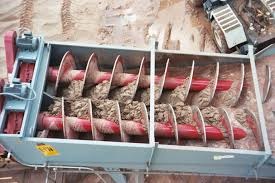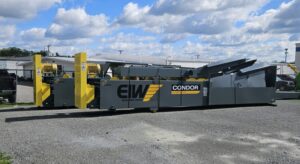As an authorized distributor of Eagle Iron Works equipment, NorX specializes in the implementation and optimization of Fine Material Washers (FMW) across diverse aggregate operations. These proven sand classification systems remain the industry standard for processing materials under 3/8″, offering superior reliability and operational efficiency with significantly lower power requirements than alternative technologies.
Technical Overview of Fine Material Washers
Fine Material Washers have established their position as essential processing equipment through decades of proven performance. Their robust design accommodates feed variations more effectively than cyclone-based systems, while maintaining consistent production rates with minimal power consumption.
Professional operators recognize that optimal performance requires precise calibration. One critical aspect our technical team addresses is product retention efficiency, specifically regarding fines loss through overflow. Regular overflow sampling and analysis are essential for maintaining optimal recovery rates.
Technical Optimization Protocols for Enhanced Performance
1. Shaft Speed Calibration
Precise shaft speed adjustment is critical for operational efficiency. When fine sand accumulation occurs in the washer box, it typically indicates excessive shaft rotation speed relative to the material gradation being processed.
Technical Consideration: Speed reduction protocols must account for proportional capacity decreases. Operating at 75% of standard speed correlates to 75% of maximum capacity. This relationship maintains linear progression throughout the speed range.
2. Weir Configuration Management
Fine Material Washers incorporate adjustable weirs on the posterior and lateral sections of the pool area. These engineering features enable precise control of water velocity during overflow processes. Maximum fines retention is achieved through elevated positioning of all three weirs.
Operational Parameters:
• Increased fines overflow: Reduce posterior weir elevation
• Enhanced fines retention: Elevate all weir positions
• Velocity control: Adjust weir height to modify water flow characteristics
3. Rising Current Water Integration
For applications processing high-silt content materials, specific gravity management becomes crucial. Implementation of fresh water introduction through the sub-plate manifold creates an engineered rising current, facilitating enhanced separation of ultra-fines while maintaining product-sized particle retention.
4. Systematic Maintenance Protocols
Professional maintenance procedures are fundamental to sustained operational excellence. Our technical specifications mandate regular inspection of:
• Drive system integrity
• Bearing seal performance
• Equipment levelness parameters
• Wear component condition
• Structural fastener security
• Lubrication system status
• Critical component wear metrics
Engineering Specifications for Operational Parameters
The correlation between material characteristics and operational parameters requires precise calibration. Speed adjustments must align with specific material gradations, particularly regarding sub-50 mesh content in the processed product.
Technical Parameters for Speed Configuration:
• Standard gradation: 100% operational speed
• Fine material processing: 75% operational speed
• Ultra-fine processing: 50% operational speed with corresponding capacity adjustments
Professional Implementation Guidelines
The proven design of Eagle Iron Works Fine Material Washers, combined with proper maintenance and operational protocols, ensures optimal classification performance across various aggregate specifications. At NorX, our service team specializes in system optimization for applications ranging from concrete sand to specialized industrial products. Contact us today at (770)338-0111.
